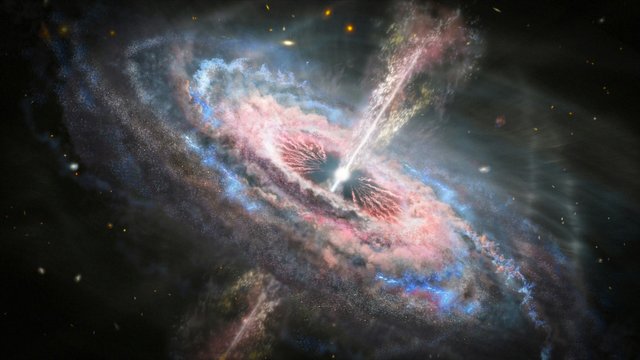Dear Steemian friends,
At first, take my cordial salam. This is @nahiansajid from #bangladesh. It's hoped that all of you are well by the grace of omni-merciful ALLAH. I am also great by the grace of almighty ALLAH.
Today, I'm going to take part in a contest in Steem For Pakistan community. The contest is titled "One Picture And One Story Week #69". It is organized by honorable @suboohi mam. I hope that all of you will enjoy my writing, as, this is written about a great mystery of physics.
One Picture And One Story Week #69
Dark Matter
Dark matter is one of the most mysterious and noteworthy constituents of the Universe. It is a type of matter which is completely opaque and can only be detected due to its gravitational influence. Despite being quite elusive, scientists believe that dark matter makes up about two-thirds 27% of the total mass-energy content of the Universe and far surpassing visible matter 5%. The remaining 68% is dark energy, an unknown force responsible for the expansion of the universe, which already accelerated.
The Evidence for Dark Matter
The concept of dark matter emerged in the early 20th century when astronomers observed gravitational anomalies that could not be explained by visible matter alone. One of the earliest pieces of evidence came from Fritz Zwicky in 1933, who studied galaxy clusters in the Coma Cluster. He further found that the observed mass of galaxies was insufficient to account for gravitational force that holds galaxies together. He coined the word "dark matter" for this (non)sensate mass.
During the 1970s, Vera Rubin and Kent Ford also provided more convincing evidence analyzing the rotation curves of the spiral galaxies. They pointed out that stars at the galaxy outskirts were rotating much faster than one would expect. According to Newtonian physics, however, their velocities should be reduced to compensate for their increasing radial distance from the center of the galactic system, where most of the apparent mass resides. However, the rotation curves remained flat, implying the presence of an unseen mass—dark matter—that extends well beyond the visible galaxy.
Properties of Dark Matter
Dark matter has no interaction, effect on electromagnetic (EM) forces, so it cannot emit or absorb light. It communicates mainly via gravity and, perhaps, via weak subatomic forces, which makes it extremely difficult to notice. Its definitive structure is not established yet but physical scientists imagine that it may or not include a set of theoretical entities such as axions, WIMPs (Weakly Interacting Massive Particles) and sterile neutrinos.
Role in The Universe
Dark matter plays a critical role in the formation and evolution of the universe. Gravitational fields at that epoch of the universe retained the gravitationally bound visible matter and formed galaxies and other large-scale structures. The universe would be, without dark matter, very different with smaller and fewer galaxies.
Further, CDM has effects on gravitational lensing with the bending of the radiation emanating from distant objects by the matter concentrations of the order of the galaxy cluster. Observing these effects, scientists have been able to delineate the distribution of the dark matter and it has been discovered to be in the shape of large, unimpeded (non-looping) structures that encase the entire space.
Challenges and Ongoing Research
In spite of its importance, dark matter is still one of the most persistent unsolved mysteries in the physics. Experiment has been conducted for direct detection of dark matter relics, such as Large Hadron Collider (LHC) and underground detectors, e.g., LUX-ZEPLIN. However, no conclusive evidence has been found.
Theoretical physicists are also looking at alternative proposals such as, e.g., Modified Newtonian Dynamics (MOND) or other versions of the theory about gravity. However, those theories are limited-range in how they are used to explain the overall structure of the universe and the dark matter hypothesis to reasonable accuracy.
Conclusion
Dark matter is the mysterious, unexplained majority of the universe that challenges our view of fundamental physics, and our view of the universe. Although the nature is unknown, the gravitation pull obtained from it is undeniable proof of its existence. Continuous advances in observational methods and theory place us at the brink of the following cosmic puzzle. UNVEILING THE TRUE NATURE OF THE DARK MATTER, would open the door to entirely new branches of physics and a new perspective on the cosmos.

| No | My invited steemit friends |
|---|---|
| 1 | @kalidsyfulla |
| 2 | @mdpolasmia |
| 3 | @mahadisalim |
